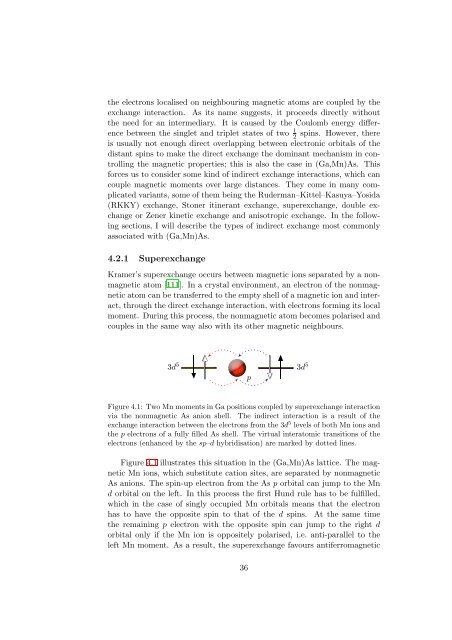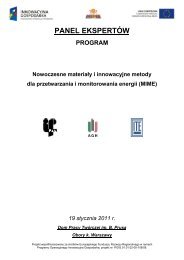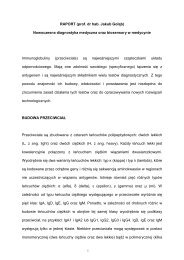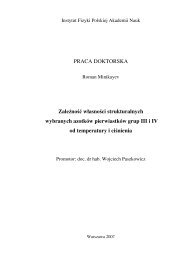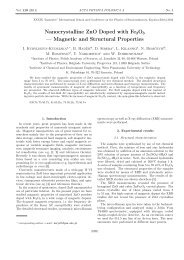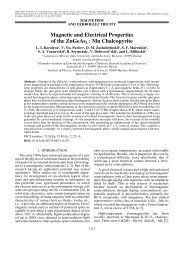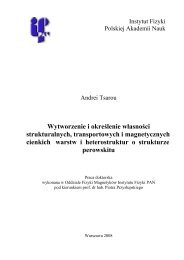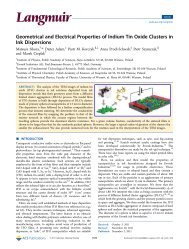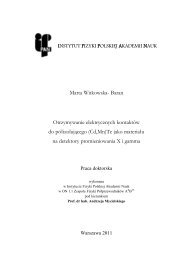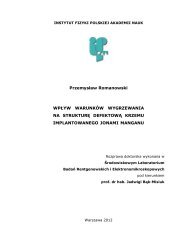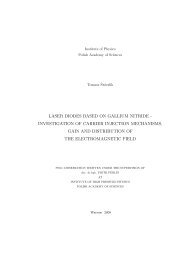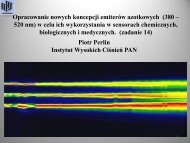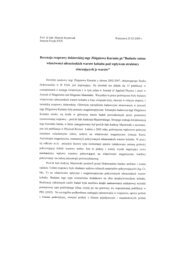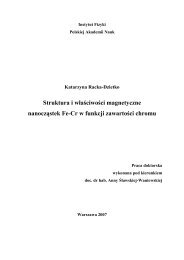Spin waves and the anomalous Hall effect in ferromagnetic (Ga,Mn)As
Spin waves and the anomalous Hall effect in ferromagnetic (Ga,Mn)As
Spin waves and the anomalous Hall effect in ferromagnetic (Ga,Mn)As
You also want an ePaper? Increase the reach of your titles
YUMPU automatically turns print PDFs into web optimized ePapers that Google loves.
<strong>the</strong> electrons localised on neighbour<strong>in</strong>g magnetic atoms are coupled by <strong>the</strong>exchange <strong>in</strong>teraction. <strong>As</strong> its name suggests, it proceeds directly without<strong>the</strong> need for an <strong>in</strong>termediary. It is caused by <strong>the</strong> Coulomb energy differencebetween <strong>the</strong> s<strong>in</strong>glet <strong>and</strong> triplet states of two 1 2sp<strong>in</strong>s. However, <strong>the</strong>reis usually not enough direct overlapp<strong>in</strong>g between electronic orbitals of <strong>the</strong>distant sp<strong>in</strong>s to make <strong>the</strong> direct exchange <strong>the</strong> dom<strong>in</strong>ant mechanism <strong>in</strong> controll<strong>in</strong>g<strong>the</strong> magnetic properties; this is also <strong>the</strong> case <strong>in</strong> (<strong>Ga</strong>,<strong>Mn</strong>)<strong>As</strong>. Thisforces us to consider some k<strong>in</strong>d of <strong>in</strong>direct exchange <strong>in</strong>teractions, which cancouple magnetic moments over large distances. They come <strong>in</strong> many complicatedvariants, some of <strong>the</strong>m be<strong>in</strong>g <strong>the</strong> Ruderman–Kittel–Kasuya–Yosida(RKKY) exchange, Stoner it<strong>in</strong>erant exchange, superexchange, double exchangeor Zener k<strong>in</strong>etic exchange <strong>and</strong> anisotropic exchange. In <strong>the</strong> follow<strong>in</strong>gsections, I will describe <strong>the</strong> types of <strong>in</strong>direct exchange most commonlyassociated with (<strong>Ga</strong>,<strong>Mn</strong>)<strong>As</strong>.4.2.1 SuperexchangeKramer’s superexchange occurs between magnetic ions separated by a nonmagneticatom [111]. In a crystal environment, an electron of <strong>the</strong> nonmagneticatom can be transferred to <strong>the</strong> empty shell of a magnetic ion <strong>and</strong> <strong>in</strong>teract,through <strong>the</strong> direct exchange <strong>in</strong>teraction, with electrons form<strong>in</strong>g its localmoment. Dur<strong>in</strong>g this process, <strong>the</strong> nonmagnetic atom becomes polarised <strong>and</strong>couples <strong>in</strong> <strong>the</strong> same way also with its o<strong>the</strong>r magnetic neighbours.3d 5 3d 5pFigure 4.1: Two <strong>Mn</strong> moments <strong>in</strong> <strong>Ga</strong> positions coupled by superexchange <strong>in</strong>teractionvia <strong>the</strong> nonmagnetic <strong>As</strong> anion shell. The <strong>in</strong>direct <strong>in</strong>teraction is a result of <strong>the</strong>exchange <strong>in</strong>teraction between <strong>the</strong> electrons from <strong>the</strong> 3d 5 levels of both <strong>Mn</strong> ions <strong>and</strong><strong>the</strong> p electrons of a fully filled <strong>As</strong> shell. The virtual <strong>in</strong>teratomic transitions of <strong>the</strong>electrons (enhanced by <strong>the</strong> sp–d hybridisation) are marked by dotted l<strong>in</strong>es.Figure 4.1 illustrates this situation <strong>in</strong> <strong>the</strong> (<strong>Ga</strong>,<strong>Mn</strong>)<strong>As</strong> lattice. The magnetic<strong>Mn</strong> ions, which substitute cation sites, are separated by nonmagnetic<strong>As</strong> anions. The sp<strong>in</strong>-up electron from <strong>the</strong> <strong>As</strong> p orbital can jump to <strong>the</strong> <strong>Mn</strong>d orbital on <strong>the</strong> left. In this process <strong>the</strong> first Hund rule has to be fulfilled,which <strong>in</strong> <strong>the</strong> case of s<strong>in</strong>gly occupied <strong>Mn</strong> orbitals means that <strong>the</strong> electronhas to have <strong>the</strong> opposite sp<strong>in</strong> to that of <strong>the</strong> d sp<strong>in</strong>s. At <strong>the</strong> same time<strong>the</strong> rema<strong>in</strong><strong>in</strong>g p electron with <strong>the</strong> opposite sp<strong>in</strong> can jump to <strong>the</strong> right dorbital only if <strong>the</strong> <strong>Mn</strong> ion is oppositely polarised, i.e. anti-parallel to <strong>the</strong>left <strong>Mn</strong> moment. <strong>As</strong> a result, <strong>the</strong> superexchange favours anti<strong>ferromagnetic</strong>36


